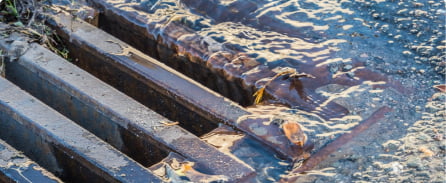Green Roofs
Green roofs have been a solution in urban areas for more than 40 years. They create greenspace in urban spaces as well as greenspaces for offices, commercial properties and mixed-use buildings.
As a green stormwater infrastructure alternative to traditional roofs, green roofs infiltrate stormwater runoff while benefiting the structure underneath. They provide additional insulation, acting as a thermal buffer for the building below while increasing the energy efficiency. These roof additions reduce stormwater discharges, which reduces the change of combined sewer systems being overwhelmed and improve water quality. Implementing this structure in your area may qualify you for credits toward the local stormwater utility fee.
Eligible green roof sites include the following:
- Do not need to sacrifice surface area, just roof space
- Have a flat or low roof slope, no more than 30 degrees
- Strong structural support. Green roofs are heavier than traditional roofing. A standard green roof is about 20 pounds per square foot after a rain event
- The roof must receive minimal wind uplift. Like a standard roof, wind pressure may damage green roofs, and potentially pull greenery off the roof
- Require rainfall absorption. Green roofs do not collect surrounding impermeable surface runoff, but instead absorbs rain that falls directly on the roof
- For Stormwater credit programs, green roofs reduce CSO, better water quality, and add green space
Different types of green roofs include
- Intensive
- Semi-intensive
- Extensive
Intensive green roofs require regular maintenance and are much more diverse. These roofs mimic a city park and often include benches and trees. Additional structural support may be required as these systems can weigh more than 80 pounds per square foot. They are the most labor-intensive green roofs to maintain and may be used for farming practices.
Semi-intensive green roofs may also have a variety of vegetation with small shrubs and ornamental grasses but will not contain tall growing trees. They function as a home for wildlife as well as stormwater filtration. Semi-intensive green roofs may require irrigation in more arid climates with less regular rainfall and weigh around 35 pounds per square foot.
Extensive green roofs are the lowest maintenance option. These roofs primarily function as stormwater filtration and will have low growing vegetation. Herbs and succulents are common alternatives for grass since they have shallow root systems. Extensive green roofs may not require extra infrastructure to support their weight as they are relatively light, 13 to 30 pounds per square foot. This green roof type is the least expensive to build and maintain.
Plants used for green roofs must be:
- Extremely weather tolerant, as roofs get especially hot during summer day and exceptionally cold during winter nights
- Drought tolerant. Green roofs do not contain much soil, allowing the entire soil substrate to dry out between infrequent rain events.
- Plants must have short root systems to prevent intrusive roots from damaging the roof or waterproofing elements
- Plants can be:
- Intensive: More work to manage, more like a traditional garden
- Extensive: Natural, less manicured growth
Green Roof Management

IMPORTANCE AND BENEFITS OF GREEN ROOF MANAGEMENT
Green roofs are installed to reduce peak flows of runoff and filter pollutants following rain events while providing aesthetic appeal. Varying types of green roofs provide a wide range of functions from filtration to recreation. These alternative roofs are less prone to leaking than the traditional counterpart, as vegetation is installed to regulate any excess runoff.
Green roofs provide water protection, water conservation, and stormwater quality benefits. Some of the benefits of green roofs include:
- Efficient and effective pollutant and contaminant removal through infiltration
- Reduction of water runoff and stormwater volume control from development site
- Effective local flood control
- Flexibility in design layout and scale, which allows it to fit in most development sites
- Good option for retrofit of existing infrastructure
- Adds aesthetic appeal to the sites
- Effective use of existing impervious, unutilized land
AQUALIS PROVIDES STORMWATER GREEN ROOF MANAGEMENT SOLUTIONS
As the green stormwater infrastructure experts, AQUALIS has significant experience in the rehabilitation and long-term maintenance of green roofs. Our goal is to design and implement green roof options that effectively filter pollutants out, slow stormwater runoff and improve water quality in a natural, aesthetically pleasing manner.
- Maintenance of a green roof includes:
- Hand weeding
- Trash removal
- Drainage inspection and leak detection to prevent water damage
- Supplemental planting when necessary
- Vegetation health assessments
- Structural inspections of waterproofing elements and building integrity
- Soil substrate inspection and evaluation for erosion and PH balance
To ensure optimal pollutant removal and flood control capabilities, a regularly scheduled maintenance plan is necessary. Partner with a professional today to properly maintain these assets and ensure optimal performance. AQUALIS management of green roofs include monitoring of vegetation health, watering, and fertilizing when necessary.


